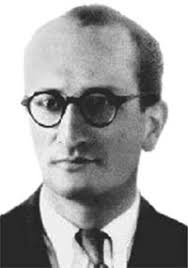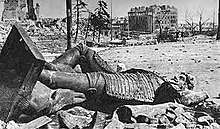Stanisław Żaryn
Stanisław Żaryn (1913–1964) was an architect, urbanist, historian and academic teacher who significantly contributed to process of reconstruction of Polish historical architecture after its destruction by Germans during WW2. He was born in Warsaw to Eugenia and Franciszek Zaryn.

Married to Aleksandra (née Jankowska) had five children: Maria (architect, designer), Anna (physician), Szczepan (journalist), Joanna (teacher) and Jan (professor of history, elected member of Polish Senate). He died, aged 50, in Inowrocław while leading summer fieldwork research on historical buildings with his Warsaw Politechnic students.
Professional history
After graduation from elite Gimnazjum Towarzystwa Ziemi Mazowieckiej, he entered Poland's leading Technical University, Warsaw Politechnic. As a student at Faculty of Architecture, he continued his specialization with Prof. Oskar Sosnowski Chair of Polish Architecture. Active in academic life, he was elected president of Architectural Students Society and publish several articles on current Architectural issues. He graduated from the Warsaw Polytechnic with the degree of Architect-Engineer, where he later received his doctorate.
He finished reserve officers artillery school (in Włodzimierz Wołyński) and In WW2 served in 1st Regiment of Horse Artillery (1 DAK). He was gravely wounded which saved him from prisoners of war death camp in Katyn. During the German occupation he was active in Polish underground resistance movement (first NSZ, National Military Organization and than AK, the Home Army).[1] Together with his wife Aleksandra, her sister Jadwiga and brother in law Władydysław Olizar, he sheltered and protected a Jewish family in their Szeligi estate, near Warsaw.[2] In 1944 he fought in the Warsaw Uprising.[3]
Immediately after the end of WW2 Zaryn formed with his architects colleagues the Department of Warszawa Historic Conservation at BOS (Office for The Capital Reconstruction). From 1948 he was historical buildings inspector and an architect of the City of Warsaw Conservation Office. In 1951 he organized and managed the innovative Research Work Group for Old Warsaw (Komisja Badan Dawnej Warszawy) which included architects, planners, historians, archeologists and artists, dedicated to research, documentation and preservation of Poland's architectural heritage.
.jpg)
From 1957-1959 served as Head of the Department of Architecture and Urban Planning of the Board of Museums and Monuments Protection.
Stanislaw Zaryn was the principal architect in charge of the design and construction of over 40 historical buildings. Among the most recognized works is Dekert city block of the Warsaw Old Town Square, housing the Archives and the Historical Museum of the City of Warsaw. His contribution included not only architectural projects, but also interior and exhibit designs (see Museum of Warsaw archives). With eng. Stanislaw Hempel, he design and supervised reconstruction of the Column of King Sigismund III Vasa - the monument destroyed in 1944 by Germans.[4] In 1980 the Historic Centre of Warsaw was recognized by UNESCO as a World Heritage Site. Despite political difficulties during communist regime, he worked closely with Church organizations in the restoration and rebuilding of several religious heritage buildings including fragments and details of Warsaw Cathedral.

As well, Zaryn was involved in several projects outside of Warsaw: Sandomierz Castle, churches in Bolimow, Lomza, Poznan Cathedral, historic townhouses in Jelenia Gora, Plock, Brzeg. (For projects documentation see: Hanna Szwankowska "Zbiory Komisji Badan Dawnej Warszawy", Muzeum Historii Polski 1997). He authored numerous articles and books on the history of architecture, conservation and reconstruction focussing on build heritage. He participated in many public lectures and radio interviews actively promoting conservation of Polish build heritage. During this period He also taught at the P.W. Faculty of Architecture with prof. Jan Zachwatowicz of Polish Architecture Chair and prof. Piotr Bieganski. From 1945 he was a lecturer and then Adjunct Professor till his death in 1964. In his teaching, Stanislaw Zaryn passed on to the next generation of architects, his extensive knowledge in the field of postwar reconstruction.
Publications
- O Zwiazku Sluchaczow Architektury P.W., Architektura i Budownictwo, pp. 122–123, 1935 Warszawa
- O Zwiazku Sluchaczow Architektury P.W., Kurier Warszawski, CXVI, 1936 Warszawa
- Professor Czeslaw Przybylski (Wspomnienia Posmiertne), Zycie Techniczne, 1936 Warszawa
- O Noakowskim-(praca zbiorowa), Lowicz pp. 43–44, 1938
- Kamienica Staromiejska, Stolica #30, 1953 Warszawa
- Kamienica Pod Murzynkiem, Stolica #31, 1953 Warszawa
- Ratusz Staromiejski, Ochrona Zabytkow 1953, nr. 2–3 p. 107
- Szkice Staromiejskie -(praca zbiorowa) Komisja Badan Dawnej Warszawy, SZTUKA 1955
- Szkice Nowomiejskie -(praca zbiorowa) Komisja Badan Dawnej Warszawy, SZTUKA 1961
- With J. Rutkowska: Wnetrza Kamienicy Barokowej, Instytut Historii PAN 1960, Historia Polski, pp. 177–197
- Dom Gotycki przy ul. Brzozowej nr.5 w Warszawie, Kwartalnik Architektury i Urbanistyki VIII, 1963, pp. 255–262
- Kamienica Warszawy XV i XVI wieku (Warsaw Town house XV and XVI century), Kwartalnik Architektury i Urbanistyki VIII, 1963, pp. 103–126
- S. Zaryn ed. "Maly Przewodnik po Warszawie"-(praca zbiorowa) Komisja Badan Dawnej Warszawy, Sport i Turystyka 1963
- Dlaczego Chronimy Zabytki, ARKADY Warszawa 1966
- Trzynascie Kamienic Staromiejskich (Thirteen Townhouses of Warsaw Old Town), PWN 1972
Work on public display
- Muzeum Historyczne m. st. Warszawy, Rynek Starego Miasta
- Centrum Interpretacji Zabytku, Ul. Brzozowa 11/13, Warszawa
Decorations and awards
- Polish People's Republic, Golden Honorary Medal "Merit for the City of Warsaw"
- Polish Silver Cross of Merit
- 10th anniversary of PRL Medal
- Awarded Polish Government State Prize (2nd degree)[5]
- Memorial plaque in recognition of his contribution, the courtyard of Warsaw Historical Museum.
- Awarded Israeli Yad Vashem Medal, Righteous Among the Nations, 1993 (posthumously)
- Named street in Warsaw (Old Mokotów), in his honour, 2008 (posthumously)
References
- Żaryn, Jan (2014). "Mialem wspanialego ojca". W Sieci Historii. 7: 58–59.
- "The Righteous Among The Nations Database". db.yadvashem.org. Yad Vashem. Retrieved 2018-12-25.
- Gmyz, Cezary; Mazurek, Robert; Krzyżak, Tomasz (2005). "Oni odkłamują przeszłość". Wprost. 25. Archived from the original on 2013-03-05.
- Zielinska-Szymanowska, Barbara (1957). "Kolumna Zygmunta III w Warszawie". Sztuka: 38.
- "Obituaries (Nekrolog)". Życie Warszawy. 172: 7. 18 July 1964.
Bibliography
- Barbasiewicz (ed.), Maria (2002). Stanisław Żaryn w służbie zabytków Warszawy (in Polish). collective work. Towarzystwo Opieki nad Zabytkami. ISBN 83-88372-21-1.CS1 maint: extra text: authors list (link)
- Bieniecki, Zdzislaw. "Biogtafia prac inz. arch. Stanislawa Zaryna", Ochrona Zabytkow 17/4/1967 p. 64-65
- Majewski, Jerzy S. "Skad sie Wziely Rzeczy w Muzeum", Gazeta Wyborcza 12/2017 Warszawa
- Muzeum Warszawy. Exhibition Catalogue "Rzeczy Warszawskie". 2017.
- PWN 1982. "Warszawskie Stare Miasto z Dziejow Odbudowy", Warszawa
- Szwankowska, Hanna. "Zbiory Komisji Badan Dawnej Warszawy", Muzeum Historii Polski 1997
- Szwankowska, Hanna, Żaryn, Aleksandra. "Stanislaw Zaryn Konserwator Zabytkow Warszawy", catalog for exhibition 1981 Muzeum Historyczne Warszawy
- TONZ 2000. "Kalendarz Milosnika Zabytkow 2001." Warszawa
- TONZ 2002. "Stanislaw Zaryn w Sluzbie Zabytkow Warszawy", Warszawa
- "Żaryn Stanisław". Internetowa encyklopedia PWN. Retrieved 2006-11-18.